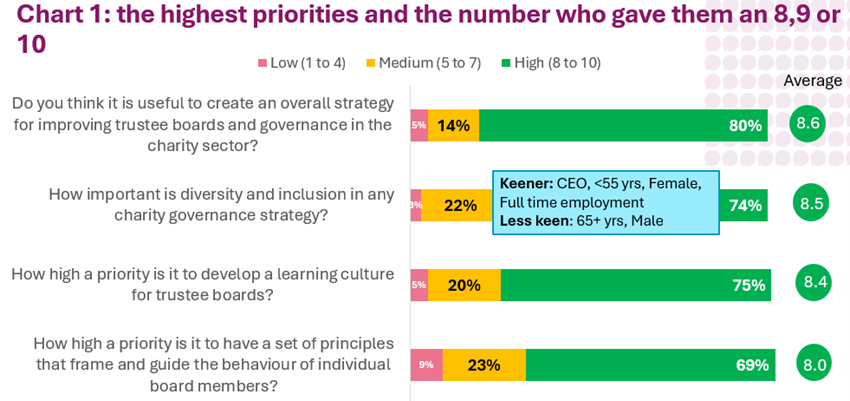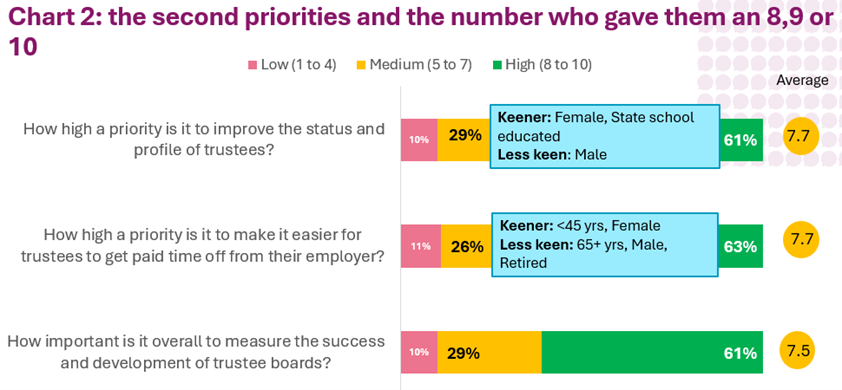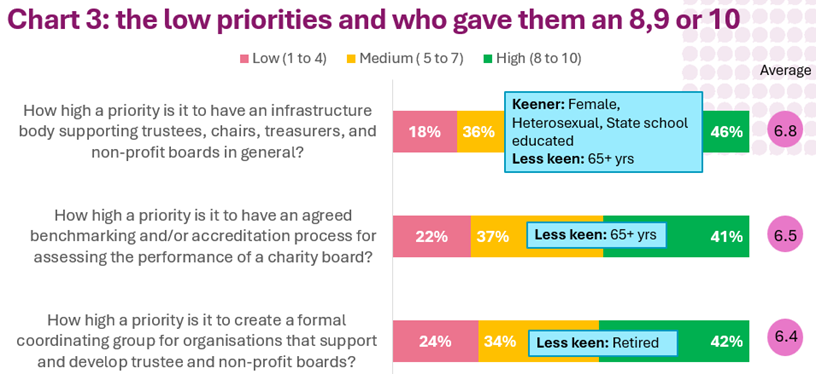The results of our consultation
Earlier this year the Association of Chairs ran a consultation about what chairs, trustees and CEOs want to see changed or developed to improve charity boards and governance. We had just over 600 responses in total. Thank you to everyone who took the time to share their insights!
Who participated?
- About half of all respondents came from organisations with a turnover of under £1 million, and about a quarter with a turnover of £1 to £5 million.
- Just over half (54%) of respondents were over 55 years old.
- 49% have Master’s degrees or PhD.
- We also had a good mix of chairs (49%), trustees and CEOs and others.
- 63% of respondents were female, 35% male, and 3% preferred not say.
What questions did they answer?
Respondents were given a list of areas and asked to rate them as priorities from 1 to 10, with 10 being the highest priority. We then also gave people a chance to make comments, and we had a range of really interesting and insightful thoughts.
The top priority areas identified by you to improve charity boards
We have divided the areas into a tier of priorities. Those with an average of 8.0 or higher we called greens. You can see this below in chart 1. It’s pleasing to see that having a strategy got the highest score overall, but that reflects why you may have completed the survey! The other three areas which got a top score were diversity, developing a learning culture and having a clear set of principles for board behaviour. On chart 1, it indicates that CEOs and those under 55 and in full-time employment were keener on diversity, and men and those over 65 were less keen.

[Chart description for accessibility: The highest priorities and the number who gave them an 8, 9, or 10. Do you think it is useful to create an overall strategy for improving trustee boards and governance in the charity sector? Low priority – 5%. Medium priority – 14%. High priority – 80%. Average 8.6. How important is diversity and inclusion in any charity governance strategy? Low priority – 3%. Medium priority – 22%. High priority – 74%. Average 8.5. How high a priority is it to develop a learning culture for trustee boards? Low priority – 5%. Medium priority – 20%. High priority – 75%. Average 8.4. How high a priority is it to have a set of principles that frame and guide the behaviour of individual board members? Low priority – 9%. Medium priority – 23%. High priority – 69%. Average 8.0.]
The high priority areas
The next tier on the list of priorities is shown in Chart 2. These are those that had a score of between 7 and 8. These priorities were improving the status and profile of trustees, making it easier for trustees to get paid time off, and measuring the overall success of trustee boards. In the blue boxes on chart 2, it shows who was keener on these priorities and who was less keen. Broadly speaking, women and younger people tended to be keener, and older, retired men tended to be less keen.

[Chart description for accessibility: The second priorities and the number who gave them an 8, 9, or 10. How high a priority is it to improve the status and profile of trustees? Low priority – 10%. Medium priority – 29%. High priority – 61%. Average 7.7. How high a priority is it to make it easier for trustees to get paid time off from their employer? Low priority – 11%. Medium priority – 26%. High priority – 63%. Average 7.7. How important is it overall to measure the success and development of trustee boards? Low priority – 10%. Medium priority – 29%. High priority – 61%. Average 7.5.]
The medium priority areas
The next tier of priorities is those with a score of between 6 and 7. This includes having an infrastructure body for trustees and charity boards in general, as well as an accreditation for charity boards and co-ordination between the different governance bodies. Again it seems to be the older respondents who are less keen on a range of these proposals, and it is women, and those who are state school educated, who want an infrastructure body.

[Chart description for accessibility: The low priorities and the number who gave them an 8, 9, or 10. How high a priority is it to have an infrastructure body supporting trustees, chairs, treasurers, and non-profit boards in general? Low priority – 18%. Medium priority – 36%. High priority – 46%. Average 6.8. How high a priority is it to have an agreed benchmarking and or accreditation process for assessing the performance of a charity board? Low priority – 22%. Medium priority – 37%. High priority – 41%. Average 6.5. How high a priority is it to create a formal coordinating group for organisations that support and develop trustee and non-profit boards? Low priority – 24%. Medium priority – 34%. High priority – 42%. Average 6.4]
The low priority areas
The lowest set of priorities is those with an average score of 5-6, with one 4. These cover paying trustees, qualifications, and developing chartered chairs and trustees.
In terms of who is keener and less keen, many of the nuances from the early priorities are the same. Older men are less keen. Women are keener. There is one significant difference. Those from large organisations are keener on paying trustees, and those from smaller organisations are less keen. This reflects the fact that for a larger organisation, the costs of paying trustees are relatively small, compared to their size. In contrast, for smaller organisations, paying trustees could take a big chunk of their budget, and is probably unaffordable.

[Chart description for accessibility: The lowest priorities and the demographic differences. Are you in favour of making it easier to pay trustees? Low priority – 36%. Medium priority – 32%. High priority – 32%. Average 5.6. How high a priority is it to develop qualifications for trustees? Low priority – 38%. Medium priority – 37%. High priority – 25%. Average 5.3. How high a priority is it to try and make it easier for trustees to be paid? Low priority – 40%. Medium priority – 35%. High priority – 25%. Average 5.2. How high a priority is it to formalise the development of qualifications to the level of having chartered chairs, treasurers, and trustees? Low priority – 55%. Medium priority – 29%. High priority – 15%. Average 4.2]
Putting this research into action
The next challenge for the Association of Chairs and those interested in this space is how to take those areas with the highest priorities into action. We will be working over the next few months to decide which areas we can make the biggest difference in, and how we might do that. One of the benefits of doing this survey is that we can work on the areas which we know will have the greatest levels of support, and we can know which type of people are likely to be the keenest, and which people we might need to work harder to persuade.
Watch this space as we turn research into action, over the next few months (and years).
Other information available
For the truly keen, we have several other bits of data and information available. This includes a set of data tables showing how the results vary according to who is answering the question by age, gender, etc. You can get these by emailing [email protected]



